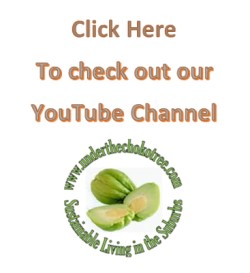Plants
As part of the de-lawning process it can be worthwhile to read up on productive plants which are not necessarily part of the traditional veggie patch. Edible weeds, edible flowers, perennial vegetables and bush foods are all worth considering, and below are some suggested books to help you out.
Permaculture Plants: A Selection – Jeff Nugent & Julia Boniface – Permanent Publications (UK) 2004 ISBN 978 1 85623 029 5 – Even though published in the UK there are an awful lot of Aus species! The book starts out with a two page overview of permaculture and one page on propagating plants, followed by the meat of the book, a series of plant lists. The lists are broken up into seven chapters. Chapter one is pioneer species (12 entries) such as wattles, casuarinas, leucaenia and alders. Chapter two covers nuts (11 entries) covering such nuts as walnuts, macadamias, almonds, bunya bunya and jojoba. Chapter three covers fruits (27 entries) including fig, loquat, pepino, sapodilla and cherimoyas. Chapter four talks about utility plants (21 entries) such as willows, neem, eucalypts and bamboos. Chapter five provides lists of other utility plants such as bee forage, companion plants, groundcovers with low fire potential, medicinal herbs for livestock and trees and shrubs with low fire potential. Chapter six covers water plants including water plants that are submerged, floating, emergent and of margins and water meadows. Chapter six covers plant lists for difficult sites including salt tolerant and tolerant of alkaline soils. Entries can vary in size from a couple of lines to a full page but are mostly a paragraph or two. Many entries are accompanied by a line drawing and there is a colour photograph section in the centre of the book.
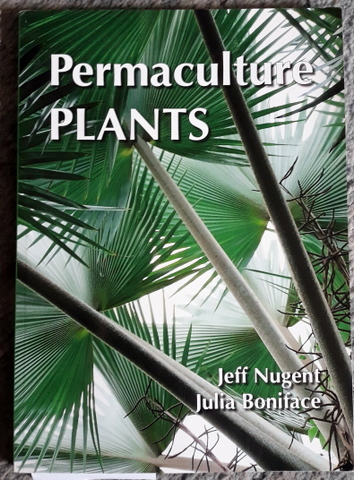
Perennial Vegetables – Eric Toensmeier – Chelsea Green Publishing Company (US) 2007 ISBN 978 1 931498 40 7 – This is THE book on perennial vegetables and as such deserves a place in your library, but bearing in mind it does reflect the US experience so not all plants mentioned will be available in Aus. The book is broken up into 3 parts. Part one covers gardening with perennial vegetables including benefits of perennial veg, design ideas, selecting species and techniques for growing. Part two, the main part of the book, is a series of monographs, called species profiles, on over 90 perennial vegetable in alphabetical order by species. Each monograph starts with a map of USA & Canada showing plant distribution and touches on – general overview and history, description, climate, tolerances and preferences, naturalisation status (in North America), pest disease and weed problems, propagation and planting, harvest and storage, uses and related species. Part Three is called ‘Resources’ and provides lists of: perennial veg for each climate type (tailored to North America but still useful), recommended reading, helpful organisations and websites and sources for plants, seeds, gardening supplies and materials (again, North American only). The book has lots and lots of colour photos.
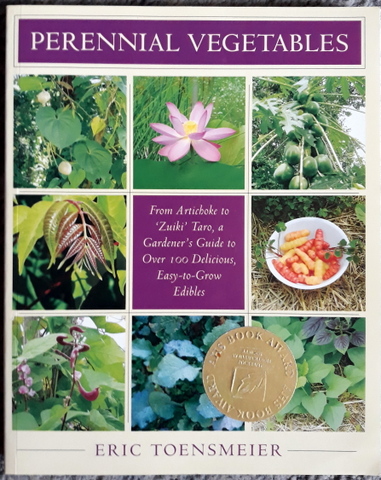
Growing Uncommon Fruits and Vegetables in Australia – Keith Smith – New Holland Publishers (AUS) 1998 ISBN 1 8646 35 1 – This book is comprised of six sections: Africa; Americas; Asia; Australia Europe and Western Asia. Plants covered are broken up into section such as grains, greens, brassicas, legumes, roots and fruit. The book covers 150 varieties of fruits and vegetables in all. The first part of each plant entry covers the family and species name, whether it is an annual or perennial, preferred climate type and common names of the plant. There is an introduction about the plant itself including some history and then a paragraph or two on how the plant should be grown. Most entries have a line drawing of the plant.

Incredible Edibles – Matthew Biggs – Dorland Kindersley Ltd (UK) 2018 ISBN 978 0 1437 6983 5 – This is an interesting book, but be aware that it reflects the UK experience. The book starts out with an intro, tips and tricks for growing like growing from seed, planting out and general care. This is followed by tips on choosing your crops such as pots, fast growers, shade loving, boggy growers, small gardens and drought tolerance. The rest of the book is broken up into a series of monographs – Fruiting vegetables (5) eg snake gourd, chickpeas; Salad vegetables (7) eg cucamelons, shiso; Leafy greens (8) eg sushi hosta, purslane; Roots, bulbs and shoots (12) eg yacon, mashua; Grains and seeds (5) eg quinoa, chia; Herbs and spices (10) eg tea, mountain pepper; and Fruit (11) eg flax-lily, fuchsia berry. Each monograph provides data in a quick guide, like temperature range, soil requirement, and water requirements followed by a description of the plant discussion of how it is grown and detailed steps on how to grow the plant including sowing directions, repotting, planting out, aftercare, harvest and winter care. This is followed by a colour photo and tips on how to keep the produce fresh, how ot eat it and how to preserve it. Lots of colour photos.

The Edible Flower Garden – Rosalind Creasy – Periplus Editions (US) 1999 ISBN 978 0 962 593 293 3 – The book is broken up into four parts. Part one is an introduction, talking about how to grow edible flowers in general and two specific edible flower gardens which the author has been involved in. Part two is the ‘encyclopaedia of flowers’ and covers how to grow and how to prepare 45 edible flowers. Part three is a compilation of 23 edible flower recipes. There is an appendix on planting and maintaining edible flowers and another one on pest and disease control. The book has lots of full colour photos.
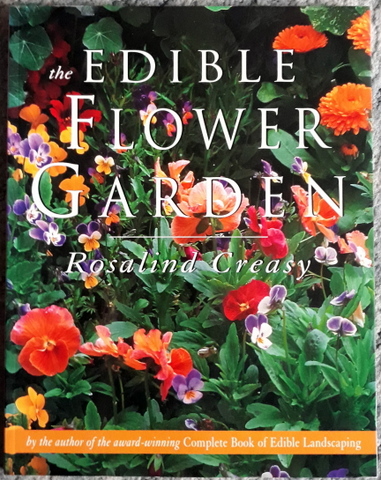
Backyard Bush Tucker – Peter Bindon – Anthony J. MacQuillan (AUS) 2014 ISBN 978 0 9804215 8 3 – The book starts with an introduction covering waterwise gardening and details about the authors own bush tucker garden in NSW. Section one of the book proper provides some suggested plant combinations based around nine Australian climate zones including tropical zone, summer rainfall eastern area; arid; temperate zone, dry summers; wetlands. Each suggested combination gives a diagram as a suggested layout and species for an upper storey, middle height, low plants and ground covers, vines and climbers. Section two is a species list of 97 general bush tucker plants, each entry being composed of a paragraph detailing the edible parts, a general description of the plant and how it is propagated. There are pages at the back of the section with colour photos of many of the plants covered. Section three provides data on four special plant groups: gum trees; wattles; figs and lilly pillys with species lists stating species, common name, height and use. Section four is a series of plant lists of other useful species and section five details resources like publications and plant sources. There are some line drawings and lots of colour photos.
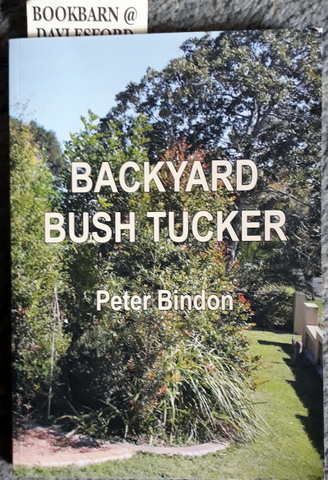
Eat Weeds – Diego Bonetto – Thames & Hudson (AUS) 2022 ISBN 978 1 760 76149 3 – The book has a foreword by Costa! Then moves through the story of Diego’s foraging journey and a short introduction about the resurging of foraging and it’s importance. The main part of the book is broken up into five parts, each part being an environment where weeds are found and covering the weeds found there. Also each part has a section at the front of the chapter that discusses legalities and ethics of gathering edible weeds in that area, Part one covers the backyard, and has monographs detailing 10 weeds; Part two covers urban streets and parklands and has monographs detailing 8 weed trees and weeds. Part three covers the sea and has monographs detailing 9 weeds. Part four covers the rivers and has monographs detailing 10 weeds. Part five covers the forest and has monographs detailing 7 mushrooms. Each monograph provides a general introduction to and history of the weed, how it may be identified broken down into leaves and stalks, flowers and seeds and roots, how it may be used as food, how it may be used as medicine and occasionally a food or medicine recipe. The book is overflowing with colour photos and some line drawings where appropriate.

Biodiversity
Another issue worth consideration when planning to de-lawn your front yard is introducing plants, structures and features that encourage native animals, insects and birds to come to your garden and stay. Following are some books which provide excellent reference material to help you include the concept of improving biodiversity into your plans.
Habitat – A.B. Bishop – Murdoch Books Australia (AUS) 2018 ISBN 978 1 76052 347 3 – The book has ten chapters in two parts, each chapter has a case study at the end illustrating how the chapter can be used in practice. Part one (Biodiversity for Life) has three chapters, chapter one details what a habitat garden is and why it is beneficial; Chapter two covers ecology and food chains/webs; chapter three discusses how food webs work in the backyard. Part Two (Backyard Habitat) starts with chapter four which talks about plants for your backyard habitat, including classes of plants such as those for food, shelter and socialising and plants for pollinators. At the end of chapter four is an extensive plant directory with photos giving data on what layer and (Aust) zone they are for, flower colour, what they contribute and how high they grow. Chapter five covers earthworms and insects and how to put in habitat to support them; chapter six does a similar thing for frogs and reptiles; with a section at the end covering pests and other undesirable visitors. Chapter seven talks about habitat to support bird life; chapter eight does a similar thing for animals such as bats, possums and gliders; Chapter nine covers hints and principles for designing habitat garden and chapter ten gives details for projects to improve the biodiversity in your area such as constructing bee/bug hotels, bat and other animal boxes and a frog pond. This is a wonderful book, with lots of colour photos!
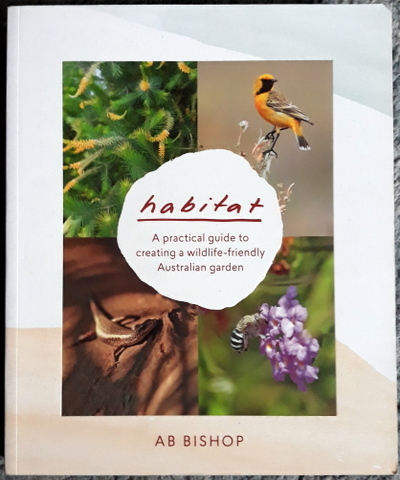
Habitat Garden – Peter Grant – ABC Books (AUS) 2008 ISBN 978 0 7333 1279 3 – This is a great book, lots of info! Chapter one covers the what and why habitat gardening chapter two talks about planning the habitat gardening, why do it, the planning process and includes some garden scenarios. Chapter three talks about propagating plants for the habitat garden; chapter four covers the activities associated with maintaining it including watering, mulching, pruning and managing weeds and pests. Chapter five covers attracting birds, insects and animals to the habitat garden, chapter six covers putting in a habitat garden in difficult areas such as coastal, rainforest and arid gardens. Chapter seven provides details on groups, nurseries and environmental care groups from plants and information can be available. Lots of colour photos.
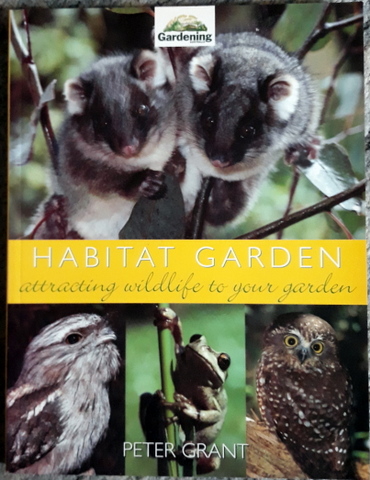
The Australian Bird Garden – Graham Pizzey – Angus & Robertson (AUS) 2000 ISBN 978 0 207 19675 3 – The book is written in four parts. Part one covers experiences from the author’s garden and travels. Part two covers the practicalities of setting up a bird-garden including what native birds need, soil, water and feeding birds, when birds fight their own reflections and nesting boxes. Part three discusses a few bird species and their behaviour, then more general information about birds as pollinators. Part four talks about plants and how they grow and interface with insects and birds. There is an appendix of plant lists by capital city with some smaller cities included. The book has lots of colour photos.

Nest Boxes for Wildlife – Alan and Stacey Franks – Blooming Books (AUS) 2006 ISBN 978 1 87647 20 7 – This small book starts by explaining why providing wildlife nest boxes is important in chapter one. Chapter two talks about the animals covered in the book and some of their habits. The main part of the book provides detailed plans, material and tool lists and instructions on how to build and mount animal nest boxes. The plans cover boxes for 17 bird species and 11 mammals. Chapter five covers providing food and water as an attractant to use the nesting boxes. The book features line drawings and lots of colour photos.
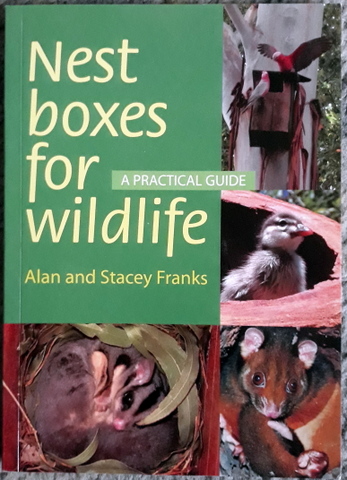
Attracting Frogs to Your Garden – Kevin Casey – Kimberley Publications (AUS) 1996 ISBN 978 0 9587628 0 5 – Again, this is a small book. But with lots of info. Chapter one talks about why there has been a decline in frog numbers and provides some hints for attracting frogs to your garden. Chapter two gives a general review of our unique amphibians, chapter three suggests some resources to assist with frog identification and details simple steps to be taken that improve frog identification. Chapter four talks about how to look for frogs and chapter five talks about frogs as pest controllers. Chapter six covers cane toad identification and eradication. Chapter seven talks about frog calls and mating while chapter eight talks about doing the right things to keep frogs happy and healthy and chapter nine talks about raising tadpoles. Chapter ten details hot to set up a backyard frog pond and chapter eleven goes through ‘frogsaping’ your backyard with the appropriate frog-friendly plants. Chapter twelve covers attracting other animals (native birds, mammals, insects etc) and chapter thirteen covers frog photography. The book has line drawings, lots of B&W photos and a couple of colour photos on the covers.
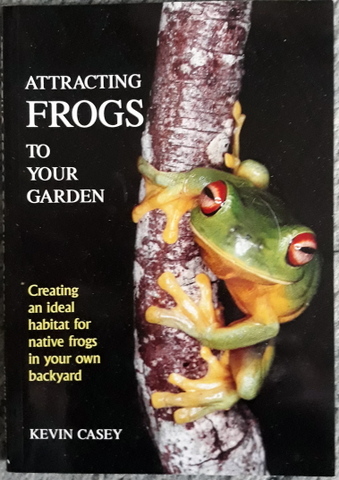
The Library - De-lawning: The Process and Edible Landscaping
Find other articles on de-lawning your front yard here


